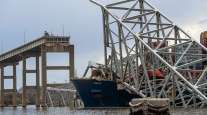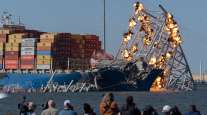New Container Terminal Planned for 2028 Opening in Maryland

[Stay on top of transportation news: Get TTNews in your inbox.]
Developers of a new $1 billion container terminal at Tradepoint Atlantic in Baltimore County, Md., say they expect to break ground by the end of next year and open in 2028, creating 1,100 jobs.
But much of that timeline depends on navigating a complex government permitting process and resolving environmental issues, such as how to safely dispose of dredge material.
On Feb. 20, the developers of Tradepoint Atlantic, a logistics hub on the former site of Bethlehem Steel in Sparrows Point, discussed their vision with federal officials from an agency that works to keep major infrastructure projects from getting tangled in red tape.
Tradepoint is building the proposed Sparrows Point Container Terminal in Coke Point in partnership with a subsidiary of shipping giant Mediterranean Shipping Co., one of the world’s largest operators of containerships and the Port of Baltimore’s largest shipping line.
MSC ranks No. 11 on the Transport Topics Top 50 list of the largest global freight companies.
Development of the 165-acre terminal with an on-dock rail facility is expected to create much-needed additional container-handling capacity in Baltimore and give the port a substantial competitive advantage along the East Coast. Tradepoint announced its joint investment and partnership with Terminal Investments Limited in October 2022.
The approximate site of the planned Sparrows Point Container Terminal.
The project has been accepted into a federal program known as FAST-41 run by the Permitting Council, a federal agency established in 2015 to help developers ease and coordinate the environmental review and authorization process. To qualify, projects must cost at least $200 million and benefit sectors such as ports and waterways, energy production, transportation, broadband, manufacturing or cybersecurity. Inclusion in FAST-41 does not necessarily speed up the process and does not guarantee permit approvals.
Instead, the agency “seeks to address some of the challenges that we routinely hear in infrastructure projects, lack of certainty about what the timeline will be, lack of transparency and challenges coordinating across agencies,” said Rebecca Higgins, the council’s chief of staff.
Such projects often require permits from the Environmental Protection Agency, Army Corps of Engineers, U.S. Fish and Wildlife Service and others.
“It can really help to elevate the project to agency leadership, making sure they’re aware of the project,” Higgins said. “We like to think there’s a benefit in even getting to ‘no’ faster, to know a project won’t move forward.”
Higgins and a team of professionals from the council toured the Coke Point site Feb. 20, walking next to a channel leading to the Patapsco River that would need to be widened and deepened to accommodate container vessels. Tradepoint tenants now use the channel for shipping in raw materials or vehicles.
COMTO's April Rai offers tips to increase workforce diversity and grow profits.. Tune in above or by going to RoadSigns.ttnews.com.
Plans call for building a 3,000-foot wharf along the length of the shore with eight ship-to-shore cranes that could berth two ultra-large container vessels, said Tom Caso, Tradepoint’s vice president of development, in a presentation to Permitting Council representatives. Containers then would be shipped via truck or on-site short-line rail that connects to CSX and Norfolk Southern.
Currently, the port’s main container terminal is Seagirt, operated by Ports America and located off Broening Highway on the Patapsco. Mediterranean Shipping had said it needs additional container-handling capacity.
Caso said Tradepoint has been working with the harbor’s vessel pilots to design its container terminal channel in such a way as to make it safe and reliable while limiting the amount of dredging.
“Probably the biggest question for this project is ‘where does the dredge material go?’ ” Caso told agency members.
Tradepoint officials are studying options. They have proposed creating a 100-acre dredge material containment facility offshore to the west of Coke Point. But they also are required to examine the environmental impact of alternatives.
Want more news? Listen to today's daily briefing above or go here for more info
Because a single offshore containment site may not be feasible, Tradepoint is looking into and testing a combination of options that could work together. They include on-site, off-site and offshore ocean disposal, that would be “regulatorily feasible and technically viable,” said Peter Haid, the developer’s vice president of environmental compliance.
Caso said Tradepoint has held public meetings on its plans, including in Sollers Point and in Turner Station, and has been meeting with an advisory board consisting of leaders from 13 communities.
Concerns have been raised about dredging, truck traffic and air emissions, all of which are being studied, he said.
Terminal plans represent a major phase of development for the 10-year-old, 3,300-acre warehouse and distribution center that has 50 tenants, among them Amazon, Under Armour, FedEx, BMW, Volkswagen and McCormick & Co. The center employs 13,000 people.
Distributed by Tribune Content Agency, LLC





